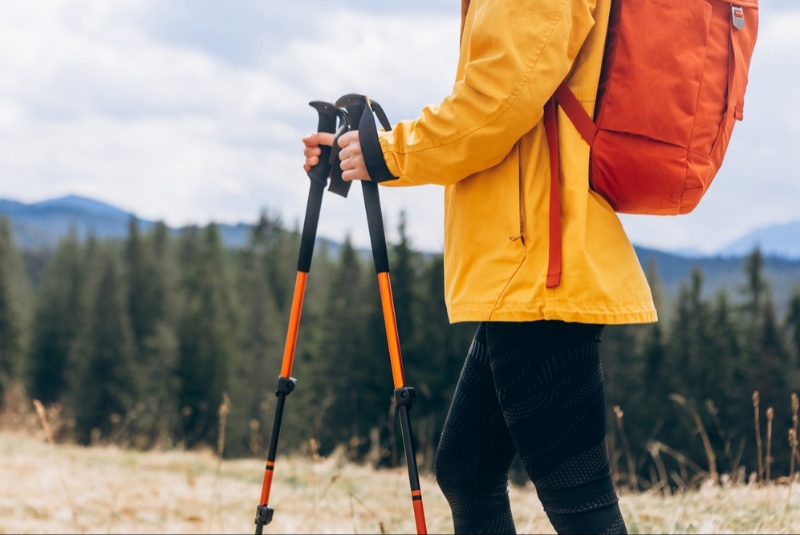Embarking on a summer hiking adventure requires preparation and the right equipment to ensure safety, comfort, and enjoyment. One of the most overlooked but essential pieces of gear is a pair of trekking poles. These tools not only enhance stability and support on varied terrains but also reduce the impact on joints during long descents. This guide will help you navigate the various features, types, and considerations necessary to choose the perfect pair of trekking poles for your summer hikes.
Why Use Trekking Poles?
Trekking poles are more than just walking sticks; they are engineered to improve your stability and support on the trail. By distributing the load more evenly through your arms and legs, they can reduce fatigue and the chance of injury, especially on longer hikes. Poles also increase your speed by providing additional propulsion and improve your balance on uneven or slippery surfaces, which can be particularly helpful during summer hikes when rain can make trails treacherous. Moreover, using trekking poles can help conserve energy over long distances, making your hikes more enjoyable.
Key Features to Consider
When choosing trekking poles, several key features need consideration to find the best fit for your hiking style and needs. The adjustability of the poles is crucial for matching them to your height and the terrain. Look for poles with a reliable locking mechanism to ensure they stay at the desired length. The material of the poles affects their weight and durability; aluminum poles are sturdy and cost-effective, while carbon fiber poles are lighter but more expensive. Additionally, the grip material—usually rubber, foam, or cork—affects comfort and sweat absorption, which is particularly important in summer when hands are more likely to sweat.
Choosing the Right Type of Poles
Trekking poles come in various types, each suited to different hiking needs. Telescopic poles are adjustable and can be shortened or lengthened as needed, making them versatile for various terrains. Folding poles are lighter and more compact but offer less adjustability. Shock-absorbing poles have internal springs that reduce impact on downhill segments, ideal for protecting joints during long descents. Ultralight poles are designed for speed and efficiency but may not offer the same level of durability and support as heavier models.
Adjustability and Locking Mechanisms
The adjustability of trekking poles is vital for adapting to different trail conditions and personal comfort. Poles that quickly adjust in length allow for easier transitions between uphill and downhill hiking, which can be a frequent requirement in mountainous terrain. The locking mechanism is equally important; it must be secure enough to prevent the poles from collapsing under pressure but also easy enough to operate when adjustments are needed. Common types include twist locks, lever locks, and push-button locks, each with its own advantages in terms of ease of use and reliability.

Materials and Weight
The material from which trekking poles are made significantly influences their overall weight, durability, and suitability for certain types of hikes. Aluminum poles are heavier but can withstand more abuse, making them suitable for rugged terrain. Carbon fiber poles are lighter and better at reducing vibrations, which is an advantage on longer or more frequent hikes but can be more susceptible to snapping if bent. Choosing the right material depends on your balance between weight preference and the type of terrain you plan to encounter.
Grip Materials and Design
The grip of trekking poles is one of the primary contact points and affects comfort significantly. Cork grips conform to the shape of your hands over time and absorb sweat, making them a great choice for hot weather hiking. Foam grips are softer and cooler, which can be more comfortable in warm conditions and for longer distances. Rubber grips are durable and insulate well against cold, although they can be slippery when wet and less comfortable in hot weather. Your choice should depend on the climate you usually hike in and personal preference regarding feel and sweat management.
Considering the Baskets and Tips
Trekking pole tips and baskets can be adjusted depending on the terrain to provide better traction and support. Tips are usually made of carbide or steel for durability and grip on rocky surfaces. Larger baskets can be beneficial in snowy or muddy conditions to prevent the poles from sinking too deep, which can be a concern in some summer hiking environments. Some poles come with interchangeable tips and baskets, allowing for customization based on the specific conditions of each hike.
Durability and Maintenance
Durability is a critical factor, especially if you hike frequently or tackle challenging trails. Carbon fiber poles require careful handling to avoid breaking under high stress, while aluminum poles may bend but are generally more forgiving. Proper maintenance, including regular cleaning and checking for damage, extends the life of your trekking poles. Lubricating the locking mechanisms and storing the poles in a dry, cool place can prevent wear and corrosion.
Additional Considerations for Summer Hiking
For summer hiking, consider poles that feature breathable straps to prevent excessive sweating and chafing. Lightweight and moisture-wicking materials can enhance comfort during long, hot hikes. Reflective materials or bright colors are beneficial for safety if you’re hiking during dawn, dusk, or in foggy conditions. Additionally, poles that pack down small are advantageous for travel or when poles need to be stowed in a backpack during flat or easy sections of the trail.
Selecting the perfect pair of trekking poles for your summer hiking adventures can greatly enhance your experience by providing support, stability, and reduced strain on your body. By considering the type of hikes you plan, the features that match your needs, and the conditions you'll encounter, you can choose a pair of poles that will be reliable companions on any trail. With the right trekking poles, you'll be well-equipped to tackle even the most challenging terrains and enjoy your hikes to the fullest.




